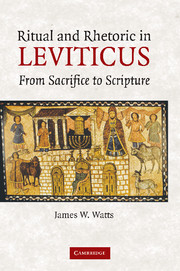Book contents
- Frontmatter
- Contents
- Abbreviations
- Preface
- Ritual and rhetoric in Leviticus
- 1 Introduction: Ritual Text and Ritual Interpretation
- 2 The Rhetoric of Ritual Instruction
- 3 The Rhetoric of Burnt Offerings
- 4 The Rhetoric of Sin, Guilt, and Ritual Offerings
- 5 The Rhetoric of Ritual Narrative
- 6 The Rhetoric of Atonement
- 7 The Rhetoric of Priesthood
- 8 The Rhetoric of Sacrifice
- 9 The Rhetoric of Scripture
- Bibliography
- Index of Biblical Citations
- Index of Other Ancient Literature
- Index of Authors
- Index of Subjects
5 - The Rhetoric of Ritual Narrative
Published online by Cambridge University Press: 22 July 2009
- Frontmatter
- Contents
- Abbreviations
- Preface
- Ritual and rhetoric in Leviticus
- 1 Introduction: Ritual Text and Ritual Interpretation
- 2 The Rhetoric of Ritual Instruction
- 3 The Rhetoric of Burnt Offerings
- 4 The Rhetoric of Sin, Guilt, and Ritual Offerings
- 5 The Rhetoric of Ritual Narrative
- 6 The Rhetoric of Atonement
- 7 The Rhetoric of Priesthood
- 8 The Rhetoric of Sacrifice
- 9 The Rhetoric of Scripture
- Bibliography
- Index of Biblical Citations
- Index of Other Ancient Literature
- Index of Authors
- Index of Subjects
Summary
After seven chapters of ritual instruction whose only narrative features are the framework statements that God spoke to Moses, the words “Moses did as YHWH commanded” in Leviticus 8:4 introduce the first, and only large-scale, narrative in the book of Leviticus. Instruction, though still prominent in Leviticus 8–10, now yields space to stories of how Moses carried out the initiation of the priests and tabernacle (Lev 8) and how Aaron then inaugurated Israel's regular worship services (Lev 9). These same words in 8:4 also announce the theme of the chapters, which frequently repeat this refrain of compliance with divine instructions. One story of disastrous noncompliance (10:1–3) breaks the pattern, but only to have it reinstated in the rest of Leviticus 10. The theme of priestly obedience is reinforced by YHWH's commission of Aaron (10:8–11) as the authoritative teacher and interpreter of the divine instructions.
The narratives of Leviticus 8–10 thus legitimize the ritual authority of the Aaronide priests by telling about their initiation by Moses himself on the basis of divine commands, and ground the high priests' interpretive authority in a divine revelation to their ancestor. The fact that their work, if done incorrectly, places them in mortal danger only emphasizes the priests' dedication and implies that the rarity of such divine outbreaks attests to their competence. In these ways, the rhetoric of the ritual narratives in Leviticus 8–10 legitimates and defends the priests' monopoly over Israel's temple offerings.
- Type
- Chapter
- Information
- Ritual and Rhetoric in LeviticusFrom Sacrifice to Scripture, pp. 97 - 129Publisher: Cambridge University PressPrint publication year: 2007



